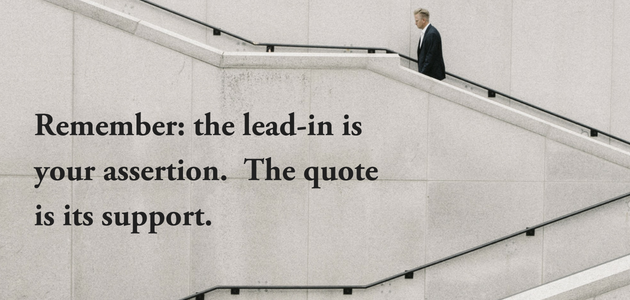Occasionally, you will need to quote four or more lines (50 or more words) of text from a key source, such as when the precise wording matters of say, a particular statute or regulation. And, every now and then, a court makes a point so perfectly—and aptly—to your argument that presenting the statement word-for-word will give powerful effect to the words you’ve used to make your assertion.
 But before you drop onto the page a quote so lengthy that it requires indentation, be sure to give it a catchy lead-in that conveys the reason why the ensuing chunk of text matters. Tie the quote to your case; tell the reader why they should plow through it.
But before you drop onto the page a quote so lengthy that it requires indentation, be sure to give it a catchy lead-in that conveys the reason why the ensuing chunk of text matters. Tie the quote to your case; tell the reader why they should plow through it.
Avoid lazy lead-ins that accomplish nothing, as in, “The court held the following” or “The witness testified as follows.”
When composing a lead-in for a block quote, ask yourself, “Why do I want to use this quote? What is its relevance? How does it support my argument and undermine my opponent’s?”
An effective lead-in could be worded and structured like this: “Dogs v. Cats [name of case or other source] shows [action verb] that dogs bark and cats meow [relevant assertion].”
As legal writing expert Bryan Garner explains in The Winning Brief, 3d ed. (2014), there are four reasons why you should say in the lead-in “what the quote does for you”:
- You’ll increase the chances that the quote actually will get read, because the reader will know beforehand why you’ve included it and will be curious to see whether it supports your argument as you say it does;
- Once the judge or clerk confirms that you’re right about the quotation, “you’ll have enhanced your credibility”;
- Because you’ve made yourself explain why you’re using the quote, it will be easier for you to include only the most pertinent words;
- Even if the reader skips the quote, your line of reasoning will still be clear.
Remember: the lead-in is your assertion. The quote is its support.
Here is an example of a strong lead-in followed by a compelling block quote, from a brief filed in the Exxon Valdez oil-spill case, as provided by Ross Guberman, in Point Made, 2d ed. (2014):
Speaking through Justice Story, its leading maritime-law scholar, the Court affirmed the Circuit Court’s ruling that the owners’ liability for the officers’ wanton acts did not extend to punitive damages:
[T]his must be pronounced a case of gross and wanton outrage, without any just provocation or excuse …. [The owners] are bound to repair all the real injuries and personal wrongs sustained by the libellants, but they are not bound to the extent of vindictive damages.
The effective advocate, as Guberman points out, resists the urge to introduce the quote with the limp words, “As the Court so aptly stated.” Note, too, that the use of an ellipsis suggests the writer used only the heart of the quote.
Get in the habit of stating the upshot of a quote in the sentence immediately preceding it. Writing good lead-ins is a handy way to strengthen your prose and enhance your credibility with the court.
Attorney Savannah Blackwell is a former news reporter who covered government and politics for more than a decade, mostly in San Francisco. She can be reached at savannah.blackwell@gmail.com. Follow her on Twitter at @SavannahBinSF


